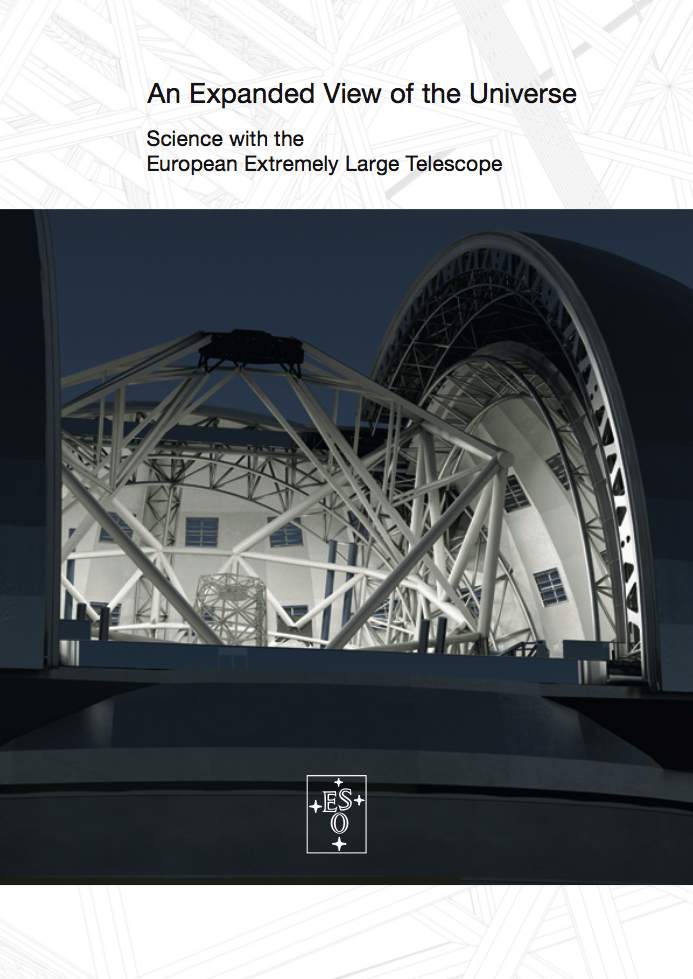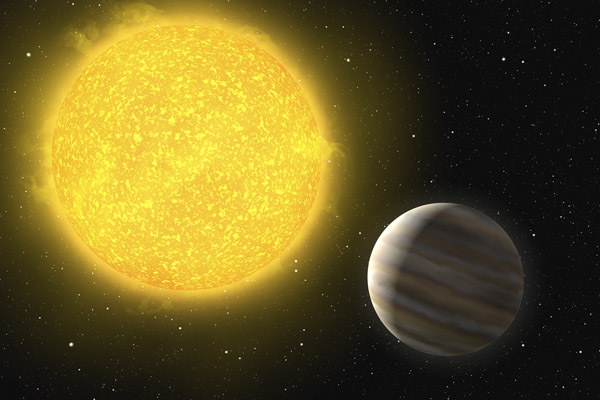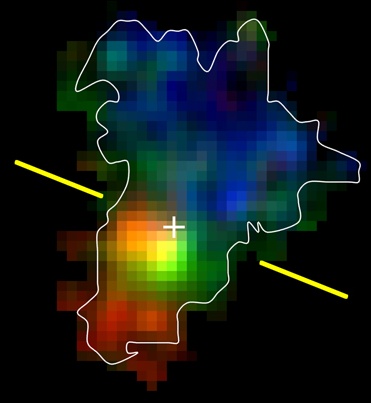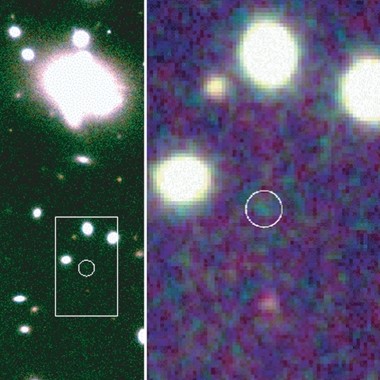SCIENCE WITH THE EUROPEAN EXTREMELY LARGE TELESCOPE
The European Extremely Large Telescope (ELT) is motivated by a wide range of scientific challenges encountered by modern astronomy. This section of the ELT web pages aims to provide information about all aspects of ELT science as well as related activities at ESO (see links to the right →).

THE ELT SCIENCE CASE SUMMARY
The book "An Expanded View of the Universe – Science with the European Extremely Large Telescope" summarises the key science cases for the ELT.
This Science Case summary was prepared at the end of 2009 with the help of:
- the ELT Science Working Group who prepared the Design Reference Mission;
- close to 200 PIs from the community that submitted cases to the Design Reference Science Plan;
- Instrument Science Teams from ~40 institutes that developed science cases for the ten phase A studies for instruments;
- the ELT Science Office team at ESO, that developed the Exposure Time Calculators and ran a large number of detailed performance simulations.
THE ELT SCIENCE CASE: EXAMPLES OF EXCITING RESEARCH TOPICS
The science case for the European Extremely Large Telescope (ELT) is drawn from many areas of astronomy and it covers a huge range of topics: from our own solar system to extra-solar planets, from nearby galaxies to the furthest observable objects at the edge of the visible Universe, from fundamental physics to cosmology. The following are a few selected examples which highlight areas where the ELT is likely to provide us with particularly dramatic advances in our understanding of the Universe around us. For more detailed information and a complete description of the Science Case please consult these documents.

Extra-solar planets
Discovering and characterising planets and proto-planetary systems around other stars will be one of the most important and exciting aspects of the ELT science programme. This will include not only the discovery of planets down to Earth-like masses using the radial velocity technique but also the direct imaging of larger planets and possibly even the characterisation of their atmospheres. The ELT will be capable of detecting reflected light from mature giant planets (Jupiter to Neptune-like) and may be able to probe their atmospheres through low resolution spectroscopy. It will also enable us to directly study planetary systems during their formation from proto-planetary discs around many nearby very young stars. Furthermore, observations of giant planets in young stellar clusters and star forming regions will trace their evolution as a function of age. Thus, the ELT will answer fundamental questions regarding planet formation and evolution, the planetary environment of other stars, and the uniqueness (or otherwise) of the Solar System and Earth.

Resolved stellar populations in a representative sample of the Universe
The ELT offers the exciting prospect of reconstructing the formation
and evolution histories of a representative sample of galaxies in the
nearby Universe by studying their resolved stellar
populations. A galaxy's stellar populations carry a memory of its
entire star formation history, and decoding this information offers
detailed insights into the galaxy's past. However, studying stellar
populations requires the capability of resolving and measuring
individual stars and so up until now such studies have been limited to
our own Galaxy and its nearest neighbours. In particular, no examples
of large elliptical galaxies are within reach of current telescopes
for this type of study.
 With its superior resolution and photon collecting power the ELT
will allow us to perform precise photometry and spectroscopy on the
stellar populations of a much more representative sample of galaxies,
reaching out to the nearest giant ellipticals at the distance of the
Virgo cluster. Thus, the ELT will provide detailed information on
the star formation, metal enrichment and kinematic histories of nearby
galaxies, showing us how they were formed and built-up over time.
With its superior resolution and photon collecting power the ELT
will allow us to perform precise photometry and spectroscopy on the
stellar populations of a much more representative sample of galaxies,
reaching out to the nearest giant ellipticals at the distance of the
Virgo cluster. Thus, the ELT will provide detailed information on
the star formation, metal enrichment and kinematic histories of nearby
galaxies, showing us how they were formed and built-up over time.
The physics of high redshift galaxies
The ELT will pursue a vigorous scientific programme of exploring the
formation and evolution of galaxies in the high redshift
Universe. Although a satisfactory scenario describing the hierarchical
assembly of dark matter halos is now well established, our physical
understanding of the build-up of the baryonic component of
galaxies is only fragmentary and fundamentally incomplete. With the
enormous sensitivity and resolution gains of the ELT we will be able
to peer beyond our present horizons and uncover the physical processes
that form and transform galaxies across cosmic time.
 The ELT will provide us with spatially resolved spectroscopic
surveys of hundreds of massive galaxies all the way out to the
redshifts of the most distant galaxies presently known, supplying us
with the kind of detailed information on their stellar masses, ages,
metallicities, star formation rates and dynamical states that is
currently only available for low redshift galaxies. The ELT will
also push back to the crucial earliest stages of galaxy formation,
right at the end of the "dark ages", by identifying the galaxies
responsible for the reionization of the Universe and by informing us
of their basic properties. Through these observations the ELT will
drive the transition from the current phenomenological models to a
much more physical understanding of galaxy formation and evolution.
The ELT will provide us with spatially resolved spectroscopic
surveys of hundreds of massive galaxies all the way out to the
redshifts of the most distant galaxies presently known, supplying us
with the kind of detailed information on their stellar masses, ages,
metallicities, star formation rates and dynamical states that is
currently only available for low redshift galaxies. The ELT will
also push back to the crucial earliest stages of galaxy formation,
right at the end of the "dark ages", by identifying the galaxies
responsible for the reionization of the Universe and by informing us
of their basic properties. Through these observations the ELT will
drive the transition from the current phenomenological models to a
much more physical understanding of galaxy formation and evolution.
Cosmology and fundamental physics
The discovery that the expansion of the Universe has recently begun to
accelerate, presumably driven by some form of dark energy, was
arguably one of the most important as well as mysterious scientific
break-throughs of the past decade.
 The ELT will help us to elucidate the nature of dark energy by
helping to discover and identify distant type Ia supernovae. These are
excellent distance indicators and can be used to map out space and its
expansion history. In addition to this geometric method the ELT will
also attempt, for the first time, to constrain dark energy by directly
observing the global dynamics of the Universe: the evolution of the
expansion rate causes a tiny time-drift in the redshifts of distant
objects and the ELT will be able to detect this effect in the
intergalactic medium. This measurement will offer a truly independent
and unique approach to the exploration of the expansion history of the
Universe. The ELT will also search for possible variations over
cosmic time of fundamental physical constants, such as the
fine-structure constant and the proton-to-electron mass ratio. An
unambiguous detection of such variations would have far-reaching
consequences for unified theories of the fundamental interactions, for
the existence of extra dimensions of space and/or time, and for the
possibility of scalar fields acting in the late Universe.
The ELT will help us to elucidate the nature of dark energy by
helping to discover and identify distant type Ia supernovae. These are
excellent distance indicators and can be used to map out space and its
expansion history. In addition to this geometric method the ELT will
also attempt, for the first time, to constrain dark energy by directly
observing the global dynamics of the Universe: the evolution of the
expansion rate causes a tiny time-drift in the redshifts of distant
objects and the ELT will be able to detect this effect in the
intergalactic medium. This measurement will offer a truly independent
and unique approach to the exploration of the expansion history of the
Universe. The ELT will also search for possible variations over
cosmic time of fundamental physical constants, such as the
fine-structure constant and the proton-to-electron mass ratio. An
unambiguous detection of such variations would have far-reaching
consequences for unified theories of the fundamental interactions, for
the existence of extra dimensions of space and/or time, and for the
possibility of scalar fields acting in the late Universe.
ELT Science
What's New?
- 05 Dec 2014
Spending on first construction phase approved
Science Case
Project Science Team
Phase B (2006 – 2011)
- Science Working Group
- Design Reference Mission
- Design Reference Science Plan
- Tools: Imaging ETC / Spectroscopic ETC / Other software
